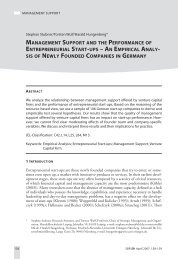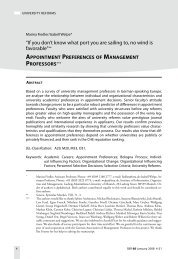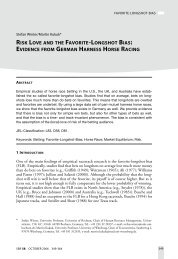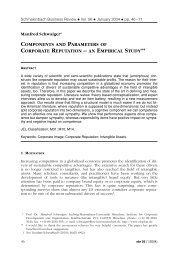“business development”? − the case of biotechnology - sbr ...
“business development”? − the case of biotechnology - sbr ...
“business development”? − the case of biotechnology - sbr ...
Create successful ePaper yourself
Turn your PDF publications into a flip-book with our unique Google optimized e-Paper software.
S. KIND/D. ZU KNYPHAUSEN-AUFSESS<br />
Since most biotech fi rms still do not have any products on <strong>the</strong> market, <strong>the</strong>ir fi rst option<br />
for how to successfully develop <strong>the</strong>ir company is not so much about market penetration,<br />
but about how to consolidate or withdraw from <strong>the</strong> market. On <strong>the</strong> industry level, a<br />
consolidation in biotech has long been expected (Persides (1999); Papadopoulos (1999))<br />
but has not really taken place. M&A activities were rare events in <strong>the</strong> last decade (Ernst &<br />
Young (2002); Wess (2003); Patzelt, Schweitzer, and zu Knyphausen-Aufseß (2005)) and<br />
have increased only very recently (Van Brunt (2005; 2006); Edelson and Ward (2007)). In<br />
contrast, many biotech fi rms went bankrupt or had to refocus <strong>the</strong>ir business, as <strong>the</strong> Medigene<br />
example shows: after negative results with <strong>the</strong>ir Etomoxir drug in clinical phases II/<br />
III, <strong>the</strong> company completely shut down its cardiovascular program in 2002 and is now<br />
concentrating on <strong>the</strong> development <strong>of</strong> anti-tumor drugs.<br />
A second option is to develop new products, e.g., drugs, which is at <strong>the</strong> core <strong>of</strong> most<br />
biotech fi rms. Recently, however, biotech fi rms have needed to develop new competencies,<br />
since pharmaceutical companies tend to in-license products at a later stage <strong>of</strong> <strong>the</strong>ir<br />
development. Th is change means that biotech fi rms must conduct at least parts <strong>of</strong> <strong>the</strong><br />
clinical trials <strong>the</strong>mselves.<br />
A third option is to develop new markets. For example, a company can enter new market<br />
segments by using competencies from one area (e.g., DNA microarrays) to ano<strong>the</strong>r (e.g.,<br />
protein microarrays). It is also possible for a company to discover a new application <strong>of</strong> a<br />
drug, which usually happens by chance, not as a planned outcome <strong>of</strong> <strong>the</strong> development <strong>of</strong><br />
<strong>the</strong> drug. Also, companies can fi nd new markets in geographic areas that were not previously<br />
covered. Since most biotech companies still have no products on <strong>the</strong> market, this<br />
option has not <strong>of</strong>ten been realized. Th is is not to say that internationalization is not a key<br />
issue: Many biotech companies have a global perspective from <strong>the</strong>ir inception, meaning<br />
that, e.g., European fi rms tend to aim drug approval at <strong>the</strong> U.S. Food and Drug Agency<br />
(FDA). At <strong>the</strong> same time, those European fi rms want to have a presence in <strong>the</strong> U.S. so<br />
that <strong>the</strong>y can develop <strong>the</strong>ir competencies by tapping into <strong>the</strong> relevant research networks<br />
(Zaby (1999)).<br />
A fourth and fi nal option is to diversify in order to realize economies <strong>of</strong> scale and scope<br />
(Teece (1980); Chandler (1990)) and to reduce risks. Zu Knyphausen-Aufseß, Zaby, and<br />
Kind (2006) show that many biotech companies do diversify <strong>the</strong>ir businesses, but fi nd<br />
that <strong>the</strong> new areas <strong>the</strong>y enter are more or less unrelated to <strong>the</strong>ir initial businesses, even<br />
if <strong>the</strong> new businesses can be classifi ed as “<strong>biotechnology</strong>” in <strong>the</strong> sense <strong>of</strong> <strong>the</strong> Standard<br />
Industrial Classifi cation (SIC) or <strong>the</strong> North American Industrial Classifi cation System<br />
(NAICS).<br />
Th e literature also <strong>of</strong>f ers insights on how to implement a BD program. Th e fi rst option<br />
is to do it yourself, i.e., to use <strong>the</strong> company’s internal resources and capabilities to bring<br />
products and services on <strong>the</strong> market. However, in <strong>the</strong> biotech industry, most companies<br />
must rely on external competencies. Th ey must ei<strong>the</strong>r acquire those competencies<br />
or engage in alliances. As mentioned above, <strong>the</strong>re have been very few M&A transactions<br />
in <strong>the</strong> past, although investors tend to think that M&As are necessary and will lead to<br />
increased shareholder value (Champsi (1998); Esposito and Ostro (1998); Schweizer and<br />
178 SBR 59 April 2007 176-199






